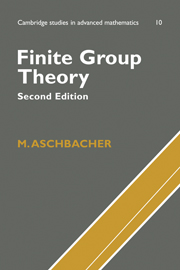Book contents
- Frontmatter
- Contents
- Preface
- 1 Preliminary results
- 2 Permutation representations
- 3 Representations of groups on groups
- 4 Linear representations
- 5 Permutation groups
- 6 Extensions of groups and modules
- 7 Spaces with forms
- 8 p-groups
- 9 Change of field of a linear representation
- 10 Presentations of groups
- 11 The generalized Fitting subgroup
- 12 Linear representations of finite groups
- 13 Transfer and fusion
- 14 The geometry of groups of Lie type
- 15 Signalizer functors
- 16 Finite simple groups
- Appendix
- References
- List of Symbols
- Index
1 - Preliminary results
Published online by Cambridge University Press: 05 June 2012
- Frontmatter
- Contents
- Preface
- 1 Preliminary results
- 2 Permutation representations
- 3 Representations of groups on groups
- 4 Linear representations
- 5 Permutation groups
- 6 Extensions of groups and modules
- 7 Spaces with forms
- 8 p-groups
- 9 Change of field of a linear representation
- 10 Presentations of groups
- 11 The generalized Fitting subgroup
- 12 Linear representations of finite groups
- 13 Transfer and fusion
- 14 The geometry of groups of Lie type
- 15 Signalizer functors
- 16 Finite simple groups
- Appendix
- References
- List of Symbols
- Index
Summary
I assume familiarity with material from a standard course on elementary algebra. A typical text for such a course is Herstein [He]. A few deeper algebraic results are also needed; they can be found for example in Lang [La]. Section 1 lists the elementary group theoretic results assumed and also contains a list of basic notation. Later sections in chapter 1 introduce some terminology and notation from a few other areas of algebra. Deeper algebraic results are introduced when they are needed.
The last section of chapter 1 contains a brief discussion of group representations. The term representation is used here in a more general sense than usual. Namely a representation of a group G will be understood to be a group homo-morphism of G into the group of automorphisms of an object X. Standard use of the term representation requires X to be a vector space.
Elementary group theory
Recall that a binary operation on a set G is a function from the set product G×G into G. Multiplicative notation will usually be used. Thus the image of a pair (x, y) under the binary operation will be written xy. The operation is associative if (xy)z = x(yz) for all x, y, z in G. The operation is commutative if xy = yx for all x, y in G.
- Type
- Chapter
- Information
- Finite Group Theory , pp. 1 - 12Publisher: Cambridge University PressPrint publication year: 2000



